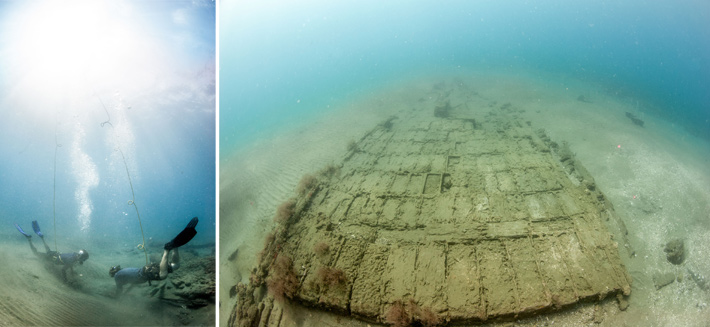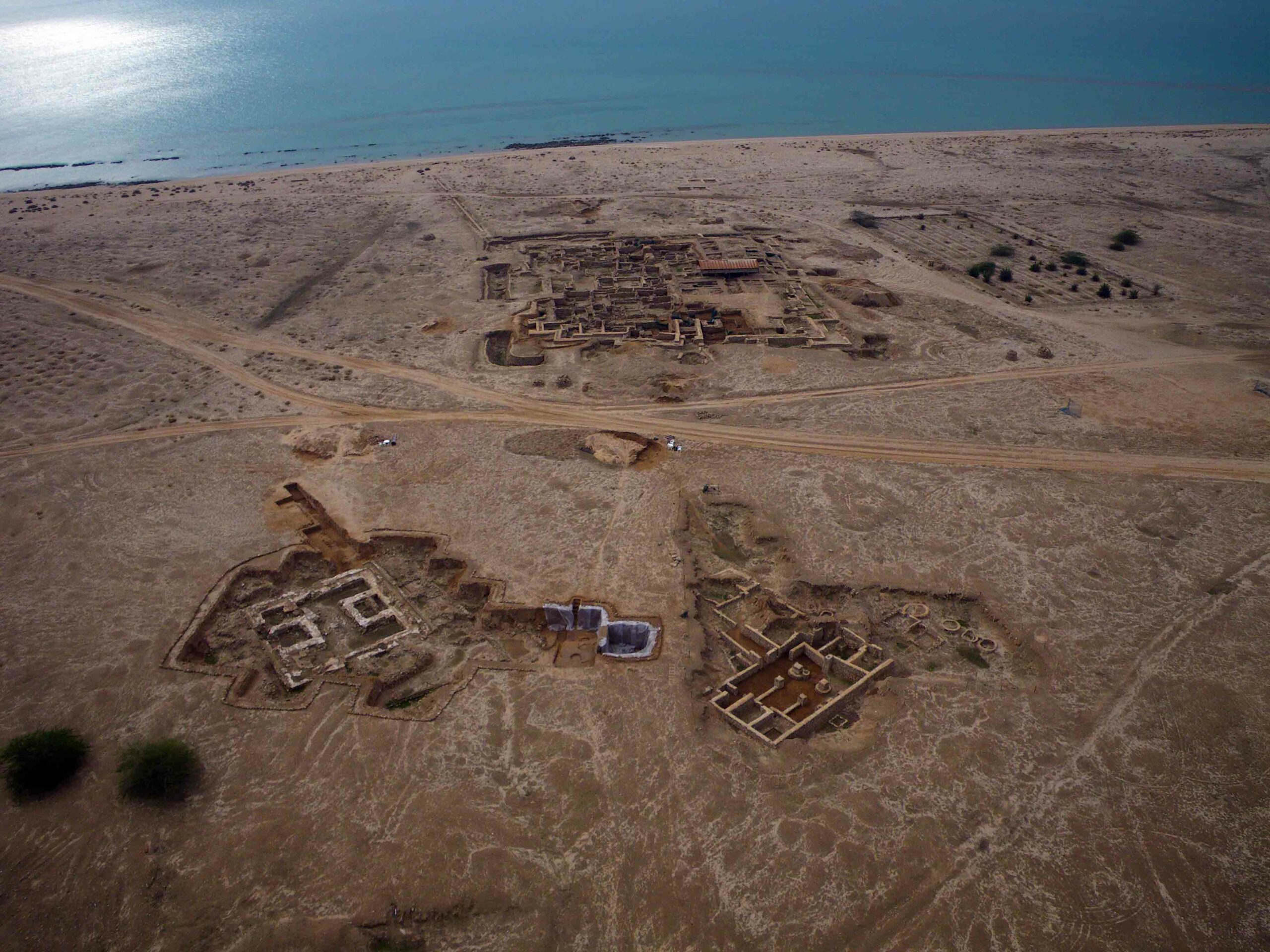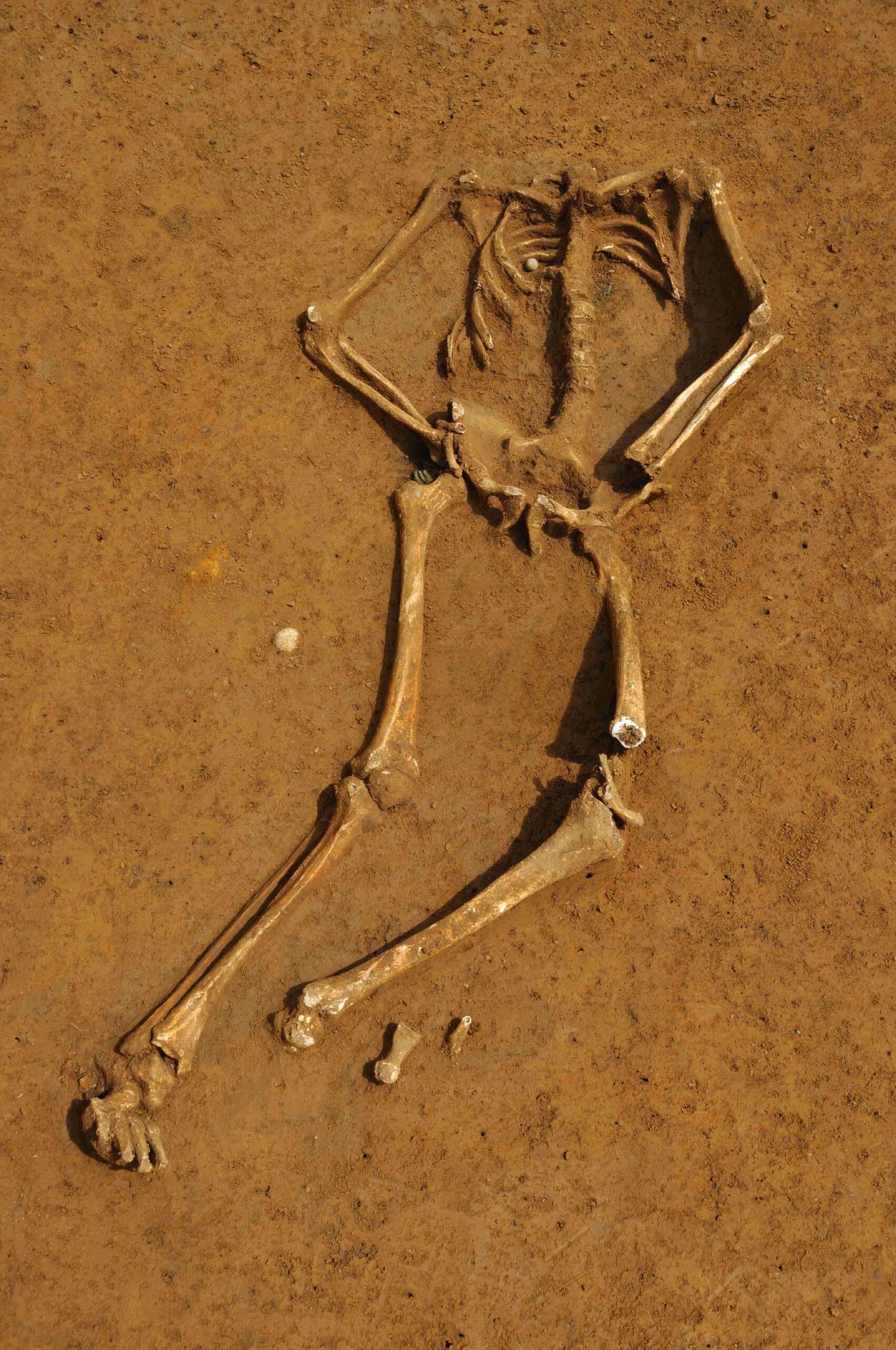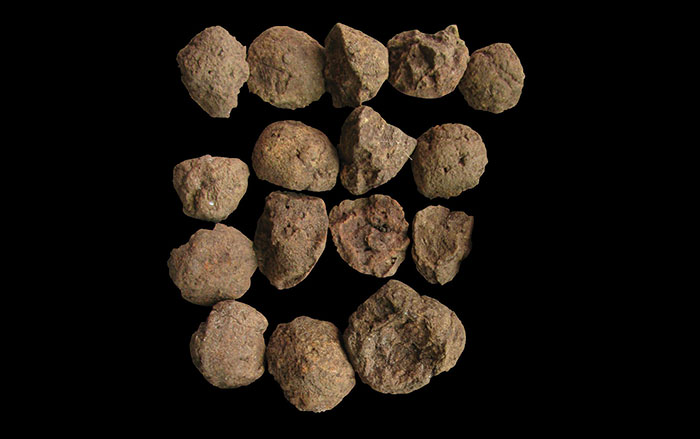
Like an illuminated skyline at sea, two dozen cargo ships wait along Panama’s Caribbean coast. One after another, they enter Limon Bay and then the Gatun locks, three hydraulic chambers that lift the ships 85 feet above sea level. They exit into Gatun Lake and then the Chagres River. After 28 miles, through a cleaved mountain ridge and under the Pan-American Highway, the ships enter more locks—the Pedro Miguel lock and the two Miraflores locks—that ease the ships back down to sea level in Balboa Harbor, just southwest of Panama City. A trip through the Panama Canal from Atlantic to Pacific takes around nine hours and costs tens of thousands of dollars in tolls.
Long before the completion of the canal in 1914, this narrowest stretch of the isthmus separating the oceans was already used to avoid an 8,000-mile detour around Cape Horn. Ships unloaded cargo at the mouth of the Chagres River, seven miles from the modern canal entrance. Flat-bottomed river barges then moved people and cargo upriver to within 13 miles of Panama City, where donkeys took over on the Camino de Cruces trail. “For four centuries the Chagres has been the bond of union between the two great oceans of the world, the way between the East and West,” wrote C.L.G. Anderson, an early-twentieth-century historian. Until the river became part of the canal it inspired—dammed to form Gatun Lake—it was the original, natural “Panama Canal.”
Beginning in the sixteenth century, the Spanish used this route to supply Panama City and move gold and silver from the city to galleons in the Caribbean. In 1671, famed English privateer Captain Henry Morgan took the largest pirate fleet in history up the river to sack the city and rattle Spain’s control of the Americas. And centuries later, during the California Gold Rush, it was easier for prospectors to take a steamer to Panama, sail up the river, then make their way north in the Pacific than it was to travel overland between America’s coasts. For all the precious metals that have traveled up and down it, the Chagres has been called “the world’s most valuable river.”
Since the first trans-isthmus railroad opened in 1855, the mouth of the Chagres River has been a backwater surrounded by a clotted jungle full of anteaters, toucans, and bellowing howler monkeys. On a promontory above, shaped like the prow of a massive ship, sit the ruins of El Castillo de San Lorenzo el Real de Chagre, or Fort San Lorenzo, which defended the important trade route between 1626 and 1741. It was sacked several times, including by Morgan’s men on their way to Panama City in 1671. Fritz Hanselmann, an underwater archaeologist at Texas State University, is looking for evidence of the privateer’s Panamanian raid—but not in the fort. He’s focused on a string of whitecaps in the sea 200 yards from it, treacherous Lajas Reef, which sank five of Morgan’s ships, including his flagship Satisfaction.
Hanselmann, stocky, ruddy, and blond as a Viking, sits in the back of a 23-foot fiberglass boat piloted by Bert Ho, a remote-sensing specialist with the U.S. National Park Service (NPS) Submerged Resources Center. It is a rare day of calm seas here, where a pileup of current and wind often makes for serious chop and queasy stomachs.

“Twenty meters,” Hanselmann calls out, “ten … five …” Aaron Wallendorf, a research diver from Texas State, leans over the side, anchor and buoy in hand.
“Now,” says Hanselmann, and Wallendorf drops the anchor. Ho guides the boat in a wide circle while the others put on scuba gear. The buoy now marks a magnetic anomaly, a variation in the earth’s magnetic field caused by a submerged metallic object. In a relatively small area around the fort and river mouth, Ho and Andres Diaz, another specialist with the NPS, detected approximately 150 of these anomalies during magnetometer surveys over the last two field seasons. Now the team needs to check out each one in person to determine if they represent modern trash, something buried too deep to dig out of the sand, the remains of a pirate ship ... or nothing at all.
Hanselmann, Wallendorf, and a visiting reporter drop down the anchor line to the sand 20 feet below. From the anchor, the divers space themselves out radially, staying in visual contact, and swim around the anchor, a technique called a circle search. With their eyes and a handheld metal detector, they quickly learn whether they will need to come back or if the anomaly can be crossed off the list. There’s nothing to see but sand, and Hanselmann wants to hit 10 or 15 more sites this afternoon. He gives a thumbs-up—time to head back up to the boat. Finding anything out here in the ocean, even in shallow water, takes skill, intuition, art—and luck.
EXPAND
City of Towers

Modern Panama City has a love affair with height. Soaring condos line the city’s waterfront. The source of this modern obsession might be visible in the very oldest part of the city—the restored bell tower at Panama Viejo, the ruins left behind following Captain Henry Morgan’s sacking of the city in 1671. One of the few Panamanian archaeologists, Tomás Mendizábal, former director of Panama’s National Museum, used to dig at the site with Patronato Panamá Viejo, the preservation group responsible for its upkeep. Panama Viejo is “the only place in Panama you can actually do research and archaeology in a country where such things are unusual,” says Mendizábal.
Just under the Spanish settlement at Panama Viejo is evidence for 1,500 years of pre-Columbian occupation. Among the early finds are several complete urn burials, as well as a burial of a woman who was laid on a bed of skulls and surrounded by nine more skulls. The find predates the Spanish town by 300 years.
The existing structures, some of which have been restored, are meant to represent the Spanish town in its final moments. The Spanish wrote that Morgan and his men burned the town on their way out. Accounts speak of a tall column of smoke. But evidence of the city’s demise has been hard to come by, says Mendizábal, who is also Panamanian codirector of the Lost Ships of Henry Morgan Project. In the ruins of what would have been city hall, on a staircase landing, is a layer of ash and charred stone steps (and the remains of a sword) that can be dated to the sacking. Across the plaza, there are layers of roofing tiles where ceilings caved in, but they were not burned. There is no other evidence of fire anywhere else. “Not one bit of ash,” says Mendizábal. “There isn’t a smoking gun, unless the whole town is a smoking gun.” This apparent lack of evidence for the well-documented burning of the town presents a puzzle, and makes the search for other evidence of Morgan’s presence in Panama even more interesting.
Mendizábal also sees the search for the remains of Morgan’s raid through a local perspective. It wasn’t just a pirate attack, it was also the destruction of a city and the intimidation and torture of a populace. “If people knew what pirates did,” he says, “it wouldn’t be quite so romantic.”
Hanselmann’s work is part of the Rio Chagres Maritime Landscape Study, which he started in 2008 with James Delgado of the National Oceanic and Atmospheric Administration, then director of the Institute of Nautical Archaeology at Texas A&M University. The nonprofit Waitt Institute was going to have a ship in the area to provide support, so Hanselmann and Delgado began a series of survey dives that January. They observed artifacts spanning 500 years, from sixteenth-century Spanish pottery to Gold Rush–era plates to modern military items. “There’s just all kinds of artifacts and material culture littering the seafloor and the mouth of the riverbed right by the fort,” Hanselmann says.

The waters aren’t kind at that time of year, and their dives on Lajas Reef were particularly treacherous. They dropped in on the ocean side of the reef, body-surfed over the top of it, and descended quickly, before the next swell had a chance to toss them around. “You’d just grab onto the nearest rock and hold on,” says Hanselmann, who was then at Indiana University. On the second survey dive, the team found some unmistakable items—encrusted with sea life, but still recognizable—in the rubble at the base of the reef. “There’s no confusing what it is,” says Delgado. “It’s not a sewer pipe. It’s a gun.”
More specifically, they were cannons, eight of them, in a variety of sizes. Nearby were three clusters of magnetic anomalies, suggesting to Hanselmann and Delgado that they had found remains of the only ships documented to have sunk on the reef—Morgan’s. There was also clear evidence that artifact collectors had been there before: cut marks, drill holes, even craters from explosives. Because the cannons were at risk from looting or being lost in a storm, Panama’s National Institute of Culture (INAC) agreed they should be raised. Hanselmann returned to the site, with Waitt Institute funding, in 2010, to remove the cannons for study before continuing with the rest of the project. “It was largely go in, get the guns, get out,” says Hanselmann.
He and his team placed straps around each cannon (ranging from approximately 200 to 900 pounds), partially inflated lift bags, moved the cannons off the reef, and then towed them by boat to a nearby boat launch, where they used a piece of sailboat decking to slide them out of the water. Hanselmann calls it their “cost-effective cannon recovery system.” Only six were recovered—the other two, the smallest ones, may have been moved by a storm. INAC did not have the facilities to store or treat the cannons. The Smithsonian Tropical Research Institute then agreed to keep them for almost a year, until a private preservation group based in Panama City, Patronato Panamá Viejo, could outfit their conservation lab to study them. They prepared the cannons for display in a museum next to the ruins of the original Spanish Panama City—the very one sacked by Morgan. If confirmed to be his, the cannons will be the only documented archaeological evidence of the pirate raid.

Captain Henry Morgan was the premier buccaneer of his age, the man who ransomed Portobello, Panama, and the man who used his own flagship as a decoy and feinted a landward attack to sneak out of heavily defended Maracaibo Harbor in Venezuela. “The name Morgan was really legend in the Caribbean,” says Stephan Talty, author of Empire of Blue Water, about Morgan’s career. His modern image—drawn largely from rum bottles—depicts a dashing, anarchic gadabout, but Morgan was more strategist than swashbuckler. He was also a patriot, from a good military family, who operated as a privateer, a pirate licensed by the British Crown to steal from other countries’ ships and settlements—especially Spain’s. “Morgan was sort of the point of the spear with regard to [England’s handling of] the Spanish Main,” says Talty.
Perhaps the boldest gambit in a career full of them was his attack on Panama City, one of the richest cities in the Spanish Main. From his base of operations in Port Royal, Jamaica, Morgan assembled a fleet of 36 ships, 1,846 men, and almost 250 cannons. Their plan was to take Fort San Lorenzo, sail up the Chagres River, and traverse the Camino de Cruces to the city—and then loot and pillage it. In January 1671, an advance party of three ships and 470 men arrived at the mouth of the Chagres, anchored nearby, and canoed and hiked in to attack the well-armed fort from the rear. For two days the Spanish soldiers fought hard, but the pirates prevailed. The rest of the fleet soon arrived. Perhaps it was an excess of enthusiasm, perhaps a navigational error, but upon arrival, five of Morgan’s ships, including his flagship, wrecked violently on Lajas Reef, just below the newly taken fort. “While he’s a brilliant military strategist with a serious stroke of luck, Morgan was not perhaps the best navigator,” says Hanselmann. They hit the reef so hard that the ships shattered, and 10 men and the fleet’s only woman (a “bruja,” or witch, Morgan kept on staff) drowned.

Undeterred, the rest of the ships avoided the reef and made it to the river. News of their arrival had reached the city, where Morgan was known as “El Diablo.” Resistance along the way was minimal. “They feared him so much, they sort of melted away,” says Talty. But the fleeing populace took supplies and most of the city’s riches with them. The privateers looted and tortured, but came away with much less plunder than they had hoped. Spanish accounts claim that Morgan’s men then burned the city to the ground, though widespread evidence for this inferno has not been found in Panama Viejo, the ruins of the original Panama City (see “City of Towers”). Afterward, the city was rebuilt in a more defensible position, but Morgan’s fleet had revealed that Spain—overstretched and debt-ridden—had at that point only a tenuous grip on the New World. “I think Morgan’s attack on Panama really begins to illustrate that rot, that their defenses were just honeycombs,” says Talty. It was, perhaps, the beginning of the end for the Spanish Main.
“Panama was pretty disappointing; it turned out to be much more important geopolitically than it was financially,” says Talty. Two months before the attack, England had signed a treaty with Spain in which England agreed to suppress piracy in the Caribbean. Though Morgan’s sacking came within the treaty’s eight-month grace period, it still proved politically inconvenient. Morgan was arrested and called back to England, but it was likely for show. He was knighted and, in 1676, was sent back to the Caribbean, this time as part of the establishment—lieutenant governor of Jamaica. He died in 1688, happy and drunk, on a 400,000-acre sugar plantation. “Piracy is not all it’s cracked up to be, perhaps,” says Hanselmann, “except for Morgan, it was.”

There are two “Old Panamas” in Panama City: Casco Viejo, the historic district where the town was rebuilt after Morgan’s attack, and Panama Viejo, the ruins of the original. Next to Panama Viejo is the museum of Patronato Panamá Viejo, which includes the conservation lab that is handling the cannons retrieved by Hanselmann and his colleagues. The six cannons rest in water baths in the facility, where researchers hope to learn how they got to be on Lajas Reef. Ruth Brown, formerly of the Royal Armouries in the Tower of London, has several decades of experience studying cannons, and was called on to help identify the Lajas Reef finds. The first telling detail is the size of the guns. They are short, of small caliber. The four smallest are likely to have been deck guns. Pirates and privateers either seized their cannons or purchased them on the secondary market, often resulting in a diverse collection of sizes and makes. No two among them are the same.
Two have been treated, using saws and wire brushes, to remove the stony concretion around them. Brown, who examined photographs of the cannons, has looked at their shapes, designs, ring patterns, settings, build quality, and markings. The cannons carry weight marks in English units and a “P” indicating they had been “proofed.” “That means someone’s tried it out and it hasn’t blown up in their face,” says Brown. After the 1690s, makers’ marks were cast on cannon trunnions, but these cannons lack such marks, strongly suggesting they were made earlier. The absence of broad arrows means they were not military cannons, but were used by English merchants or pirates. “Everything is consistent with what you would expect [for a Morgan ship], but there’s no killer blow either way,” says Brown. She hopes that one of the others might hold a maker’s mark that will help pin the age of the cannons down more securely. The evidence so far, and the fact that no other ships from the period are known to have wrecked on the reef, help make a strong circumstantial case that Hanselmann’s team has indeed found the only known archaeological remains of Morgan’s Panamanian raid.
There are tantalizing hints that more lies buried near the reef. Damage on the reef suggests that much has already been removed. Online auctions have offered items claimed to have come from Lajas Reef, including a hand grenade, a breechblock, and a 17-inch pewter plate marked “Port Royal”—perhaps direct evidence of Morgan’s presence. Also, a report from a treasure hunter in the 1970s stated that there were once more than 140 cannons on the reef, along with 22 anchors, thousands of cannonballs, buckles, muskets, and even an inscribed pocket watch. When the same man returned years later, most of the material was gone. But some may remain, buried under the sand. “We have some really promising clusters of anomalies that are just to the west of the reef,” says Hanselmann. “Given prevailing winds, river current, and ocean current, that would be a good [resting] place for ships that sank after having hit the reef and then being pushed off.”
Hanselmann and his team hope to find remains of the ships themselves, which could tell them about life in a privateer fleet. “We don’t know much about what it really, truly was like to be a pirate or a privateer,” says Hanselmann. Pirate society was known for a certain kind of egalitarianism. If significant portions of ships are found, spatial analysis of their layouts or modifications might reveal some of these social dynamics, such as whether Morgan had his own cabin or shared quarters with his men, as some pirate captains had. The design of the ship itself could reflect its culture.

After announcing the retrieval of the cannons in a press conference in 2010, Hanselmann’s team was approached by representatives of the Captain Morgan Rum Brand. Sensing an opportunity for marketing and media, they asked how they could help. “Well, write us a check,” Hanselmann told them. So they did—supporting the last two field seasons. The 2011 expedition was the team’s first full field season of magnetometer surveys and circle searches, followed by another in 2012. They have already found one shipwreck, perhaps a Spanish merchant vessel, that is helping provide some of the socioeconomic context into which Morgan’s fleet sailed in 1671.
It is thought—with good reason—that there are many more wrecks to be found among the magnetic anomalies beyond Lajas Reef. Twenty ships are known to have gone down in the immediate area, with more than 12 from the Gold Rush period alone, including Lafayette, a steamer that burned with Gold Rush passengers aboard in 1851. There are possibly many more. The search for Morgan’s ships is just one piece of what will be a cluster of projects looking at different wrecks, different time periods, and related sites on land, including the fort and the now-vanished Gold Rush boomtown known as Yankee Chagres. “Through this overarching study, people can now pick certain aspects and begin to work on them,” says Delgado. “It’s a tremendous laboratory for ongoing archaeological work.
“It doesn’t take long to realize what an important role Panama played, not just in U.S. history, but in world history, as one of the major links in maritime trade that united the world, from pre-Columbian days to the Spanish Empire to the creation of the isthmus as a transit point during the Gold Rush,” he adds. “Whatever happens here is a lifetime of work, not just for one archaeologist, but for a group of archaeologists.” “We’ve just barely started,” says Hanselmann.
EXPAND
Horseshoe Wreck

In 2010, a team led by Fritz Hanselmann of Texas State University retrieved six cannons that may have belonged to notorious privateer Captain Henry Morgan from Lajas Reef in Panama. A year later, Hanselmann returned to the Caribbean mouth of the Panama Canal with a crack team of maritime archaeologists to look for more. Investigating one of the anomalies recorded during magnetometer surveys, the team saw what appeared to be a rocky coral outcrop. Further investigation showed it to be encrusted wood. Within an hour, Hanselmann and his team had found a wooden chest with a latch on it.

At the beginning of the 2012 season, Hanselmann and his team returned to the site for more investigation and documentation. The wreck is nestled in the soft sandy seafloor under 25 feet of water. Using a makeshift water cannon, Hanselmann cleared the accumulated sand from the wreck, revealing a strange grid: a floor of wooden boxes, packed tightly, in perfect rows. The tops of a few of the boxes are gone and their contents visible, including concreted masses of horseshoes (providing the wreck with its name, the “Horseshoe Wreck,” though they’re more likely to have been used on donkeys), in addition to nails, and other supplies. Some of the wood carries a herringbone pattern, perhaps from nets used to secure it on the ship. The team has documented more than 75 chests and portions of the wooden hull. Lead cargo seals indicate it was most likely a Spanish merchant ship. One candidate is Chaperone, a ship from the Tierra Firme Armada known to have foundered in heavy seas in 1681 at the mouth of the Chagres, or it may be a barge that sank while removing Chaperone’s cargo was being removed. In providing a picture of Spanish commerce at a time when their New World empire was faltering, the wreck offers more information about the struggling economy of the Spanish Main when Morgan arrived.
For example, one of the seals has a fleur-de-lis on it, suggesting French origin. At the time, the Spanish had clamped down on trade with external parties. But people in the overstretched empire may have had to trade wherever and with whomever they could. The seal hints at an “undocumented, unspoken black market occurring across nationalities,” says Hanselmann. Perhaps this economic strain is one reason that Morgan met with so little resistance in his march to Panama City.
“They’re all intertwined and they’re all interconnected,” says Hanselmann of the Horseshoe Wreck and the other wrecks—Morgan’s—he still hopes to find.










